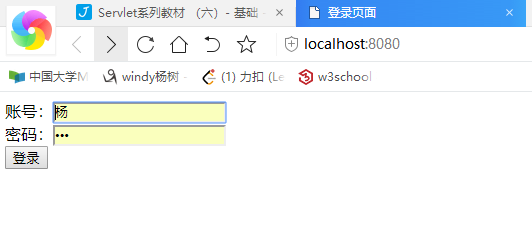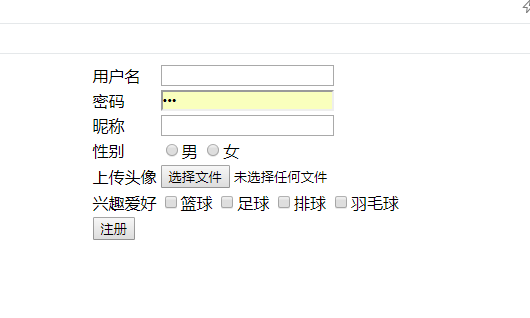1 使用Servlet获取数据
使用Servlet获取前端的数据,在后端从控制台中打印出前端的数据,前端页面如下图

前端页面程序:需要注意的是form的提交,以及input的不同类型对应的显示不同
<%@ page contentType="text/html;charset=UTF-8" language="java" %> <html> <head> <title>登录页面</title> </head> <body> <form action="login" method="post"> <!--Servlet根据name的名字获取相应的值--> 账号:<input type="text" name="name"> <br> 密码:<input type="password" name="password"> <br> <input type="submit" value="登录"> </form> </body> </html>
后端程序:后端需要创建相应的Servlet类
package cn.uestc; import javax.servlet.ServletException; import javax.servlet.http.HttpServlet; import javax.servlet.http.HttpServletRequest; import javax.servlet.http.HttpServletResponse; import java.io.IOException; /** * 使用Servlet来获取请求的参数 */ //@WebServlet(name = "LoginServlet", urlPatterns="/login") //使用注解的方式来配置Servlet,name=类名,urlPatterns=前段访问的地址 public class LoginServlet extends HttpServlet { protected void doPost(HttpServletRequest request, HttpServletResponse response) throws ServletException, IOException { request.setCharacterEncoding("UTF-8"); //为了解决输出中文乱码问题,java内部要设置为utf-8 String name = request.getParameter("name"); String password = request.getParameter("password"); System.out.println("name: " + name); System.out.println("password: " + password); } protected void doGet(HttpServletRequest request, HttpServletResponse response) throws ServletException, IOException { } }
在上面代码中有一个注解被我注释了,这是Servlet的注解有了这个在web.xml中就可以不用再写了,注解一般在小项目中使用,因为灵活方便,但在大项目中就显得不方便管理了。
因为注解被注释了,所以下面为web.xml中的配置:
<?xml version="1.0" encoding="UTF-8"?> <web-app xmlns="http://xmlns.jcp.org/xml/ns/javaee" xmlns:xsi="http://www.w3.org/2001/XMLSchema-instance" xsi:schemaLocation="http://xmlns.jcp.org/xml/ns/javaee http://xmlns.jcp.org/xml/ns/javaee/web-app_4_0.xsd" version="4.0"> <servlet> <servlet-name>LoginServlet</servlet-name> <servlet-class>cn.uestc.LoginServlet</servlet-class> </servlet> <servlet-mapping> <servlet-name>LoginServlet</servlet-name> <url-pattern>/login</url-pattern> </servlet-mapping> </web-app>
上面即为基础的功能,可以在此基础上进行优化,下面是多种方式的提交:

<%@ page contentType="text/html;charset=UTF-8" language="java" %> <html> <head> <title>登录页面</title> </head> <body> <div align="center"> <!--控制整个表单居中--> <!-- 在这里有头像的上传即是文件的上传,所以有必要了解文件上传的特殊要求 文件上传的条件 * 表单必须是post提交方式 * 表单中必须有文件上传项,文件上传项必须有name属性和值 * 表单的enctype属性必须设置为multipart/form-data --> <form action="/login" method="post" enctype="multipart/form-data"> <table align="center"> <tr> <td class="td1">用户名</td> <td><input type="text" name="username"></td> </tr> <tr> <td>密码</td> <td><input type="password" name="password"></td> </tr> <tr> <td>昵称</td> <td><input type="text" name="nickname"></td> </tr> <tr> <td >性别</td> <td> <!--单选按钮--> <input type="radio" name="sex" value="male">男 <input type="radio" name="sex" value="female">女 </td> </tr> <tr> <td >上传头像</td> <td><input type="file" id="photo" name="upload"></td> </tr> <tr> <td >兴趣爱好</td> <!--复选框--> <td><label> <input type="checkbox" name="hobby" value="篮球">篮球 <input type="checkbox" name="hobby" value="足球">足球 <input type="checkbox" name="hobby" value="排球">排球 <input type="checkbox" name="hobby" value="羽毛球">羽毛球 </label></td> </tr> <tr> <td colspan="2"> <input type="submit" value="注册"> </td> </tr> </table> </form> </div> </body> </html>
2 Servlet跳转
Servlet的跳转分两种:服务端跳转与客户端跳转,在客户端跳转时相当于从新提交了申请,浏览器地址会发生改变而服务端则不会,一般常用的也是客户端跳转

代码部分稍有不同只是跳转的界面不同,当失败时没有失败界面仍是登录界面
public class LoginServlet extends HttpServlet { protected void doPost(HttpServletRequest request, HttpServletResponse response) throws ServletException, IOException { request.setCharacterEncoding("UTF-8"); //为了解决输出中文乱码问题,java内部要设置为utf-8 String name = request.getParameter("name"); String password = request.getParameter("password"); System.out.println( "1234"); System.out.println( name +" " +password); if ("admin".equals(name) && "123".equals(password)){ //进行服务端跳转 request.getRequestDispatcher("success.jsp").forward(request,response); }else { //进行客户端跳转 response.sendRedirect("index.jsp"); } } protected void doGet(HttpServletRequest request, HttpServletResponse response) throws ServletException, IOException { } }
3 Filter拦截优化
上面实现了简单的登录功能,但有两点问题,(1)由于中文字符的问题,所以如果后续其他Servlet要用到用户名就需要在每个Servlet中进行编码设置,虽然只有一行代码但仍不想设置(2)有安全性问题,如果直接访问success.jsp那么就相当于没有登录就直接访问登录成功后的界面了。基于这两个问题的解决采用的是过滤器的方式。
UserFilter类:
public class UserFilter implements Filter { private String encoding; @Override public void init(FilterConfig filterConfig) throws ServletException { //获取配置字符集信息 this.encoding = filterConfig.getInitParameter("encoding"); } @Override public void doFilter(ServletRequest servletRequest, ServletResponse servletResponse, FilterChain filterChain) throws IOException, ServletException { //设置请求字符集 servletRequest.setCharacterEncoding(encoding); // 涉及到HTTP请求处理,转型处理 HttpServletRequest hrequest = (HttpServletRequest) servletRequest; // 涉及到HTTP请求处理,转型处理 HttpServletResponse hresponse = (HttpServletResponse) servletResponse; // 判断用户是否完成了登录操作,session中是否存储用户名 String loginUser = (String) hrequest.getSession().getAttribute("name"); //决定是否放行 if (loginUser == null) { // 未登录,系统强制重定向至登录页面 hresponse.sendRedirect(hrequest.getContextPath() + "/index.jsp"); return; } else { filterChain.doFilter(hrequest, hresponse); return; } } @Override public void destroy() { } }
对UserFilter类进行配置,在配置时要注意Filter要在最前面
<filter> <filter-name>UserFilter</filter-name> <filter-class>cn.uestc.UserFilter</filter-class> <init-param> <!-- 初始化中根据encoding名字寻找配置的字符集--> <param-name>encoding</param-name> <param-value>UTF-8</param-value> </init-param> </filter> <!-- 配置要拦截的页面 --> <filter-mapping> <filter-name>UserFilter</filter-name> <url-pattern>/success.jsp</url-pattern> </filter-mapping> <servlet> <servlet-name>LoginServlet</servlet-name> <servlet-class>cn.uestc.LoginServlet</servlet-class> </servlet> <servlet-mapping> <servlet-name>LoginServlet</servlet-name> <url-pattern>/login</url-pattern> </servlet-mapping>
0